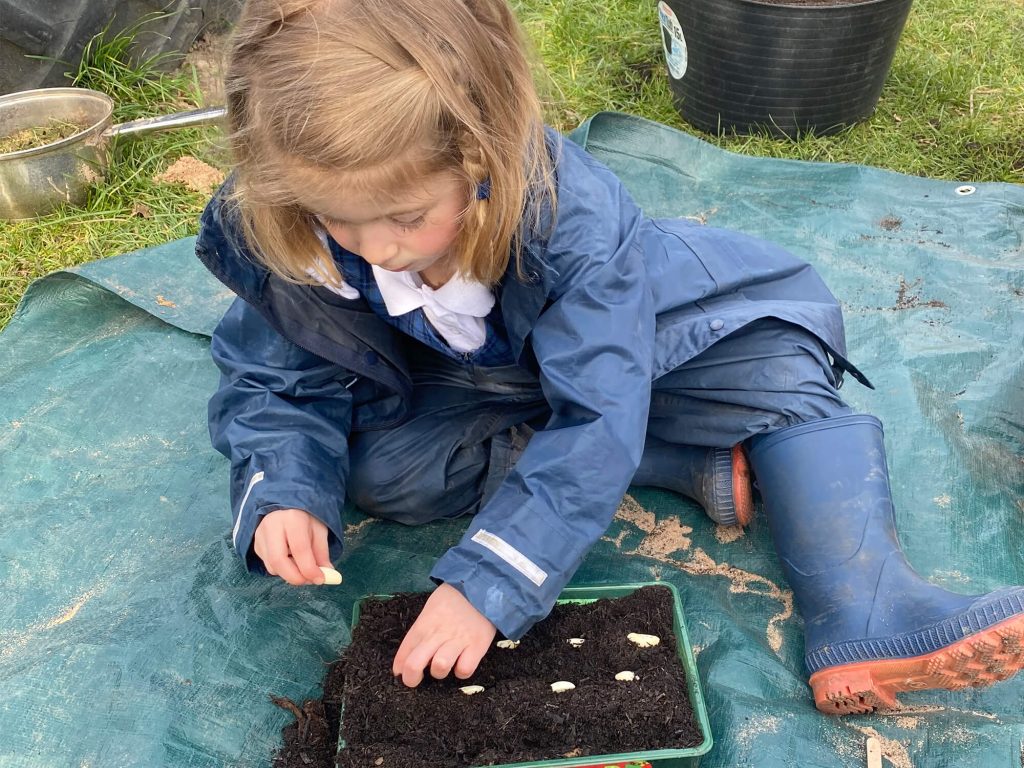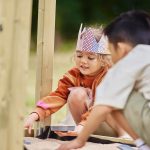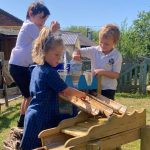
Creating a fun and safe outdoor play space at home is a fantastic way to foster children’s curiosity, creativity, and love for nature.
In this blog post, we will explore practical tips and ideas shared by Mrs Emma Bowden, Head of Outdoor Learning, from Burton Hathow School to help you create an engaging outdoor play area that encourages learning, exploration, and, most importantly, fun. Then we’ll explore some creative ideas on how to utilise your play space, from gardening activities to sensory play. Let’s dive into the outdoors and unleash adventure right in your own garden.

“It’s about firing up children’s imagination, and in the garden, they can do so much.” – Mrs Emma Bowden, Head of Outdoor Learning, Burton Hathow Preparatory School
How to create an outdoor learning play space
Let’s look at what you can do to help make your outdoor play space a fun area for your little ones, considering factors such as placement, comfort, and personalisation…
Choose a location
To create an outdoor learning play space, the first step is to choose the right location. Look for an area in your garden that is safe and easily accessible. It should also have a good amount of sunlight and natural elements such as trees or plants for shade and visual appeal. By selecting a suitable location, you can create an engaging and inspiring outdoor environment your children will love.

Make it comfortable
To encourage children to spend more time in the outdoor play space, it’s essential to make it comfortable and inviting. Begin by ensuring that the area is free from any hazards or obstacles and is safe for little ones to explore.
Create a cosy outdoor space for children to relax, read, and observe. Include comfortable seating options like benches or outdoor cushions, a small table for writing or drawing, and a cosy reading nook with bean bags or a hammock. By providing a comfortable environment, children will develop a love for learning and exploring the outdoors, making their special space a favourite place to be.

Encourage children to personalise the space
Children feel a strong sense of ownership and connection when they are involved in personalising their play spaces. Encourage your little ones to add their personal touches and make the outdoor learning area their own. Provide opportunities for them to decorate the space with their artwork, craft projects, or handmade signs.
Empower children to take pride in their learning environment by involving them in the process of designing and arranging their place space, by choosing their favourite climbing frame or by deciding where the cosy area will be and where the sandpit will go, for example. This way, they can express their creativity and preferences.

Outdoor play activities to try at home
Now that your children have set up the perfect outdoor play space, it’s time to get creative and encourage them to use the space to play, learn and discover the world outdoors. Here are some suggestions to help them get the most out of their new space.
Garden Exploration
Creating an outdoor space in your own garden is a wonderful way to facilitate outdoor learning for your children. Emma recommends getting them involved in gardening activities, such as planting seeds and watching them grow. Even if you have limited space, a small area, like a window box, can be used to plant seeds. Your children can take care of their plants and learn about plant care, nature, and the outdoors while participating in gardening.
Additionally, providing children with resources like sticks, old sheets, and natural materials can stimulate their imagination and creativity, allowing them to transform these simple items into endless possibilities. “By using their imagination, a simple natural object can be so many things,” Emma emphasises.

Sensory Play
Looking for a fun way to get kids interested in nature? Consider setting up a water play area in your outdoor space. Keep reading to find out how to create your own nature water exploration station.
Look for an easily reachable area in your garden and put a big plastic tub or water activity table there. Fill it up with water from an outdoor source, like a hose or bucket.
Encourage your little nature lovers to gather a variety of natural materials from their surroundings. You can provide them with buckets or baskets to collect rocks, shells, leaves, twigs, pinecones, or any other objects they find fascinating. This step will help them connect with nature and observe the different elements present in their outdoor space.
Give the kids watering cans, cups, and scoops and suggest they pour, splash, and scoop water to develop their fine motor skills and explore their senses. Encourage them to observe how the water interacts with the natural materials they gathered, like pouring water over rocks to see how it changes them or floating leaves and twigs to watch how they move in the water.
During the activity, talk to the children about why it’s important to save water and protect the environment. Discuss different ways to save water and keep natural sources like rivers, lakes, and oceans safe. Encourage them to think of ways they can save water at home.

Bonus Tip – Nature Beyond the Garden
Emma recommends taking regular nature walks with children to spark their curiosity and imagination. During these walks, she suggests engaging in activities such as litter picking with a community group or bird spotting, which will promote a sense of responsibility and lead to a deeper understanding of the environment.

By implementing these practical ideas to create an enriching outdoor play space at home and embrace the wonders of nature, you can create a captivating outdoor play haven that encourages your children to learn, explore, and have fun. So, step outside, unleash adventure, and watch as your children’s love for nature and learning blossoms in the great outdoors.



